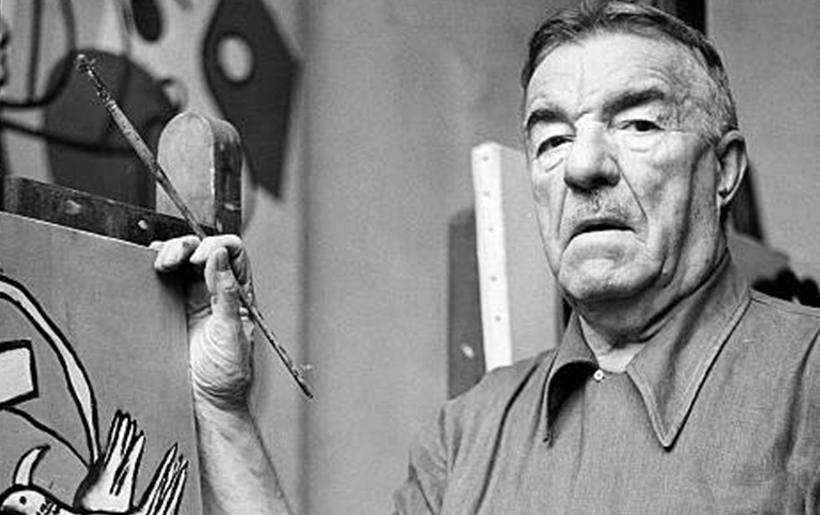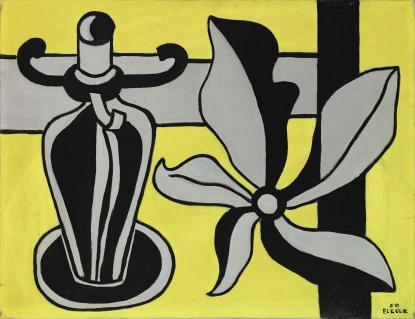Fernand Léger
A vital figure in the development of Cubism, Fernand Léger was born in 1881 in a small town in Normandy, France. He apprenticed to an architect in his hometown and moved to Paris in 1900, where he studied painting at the School of Decorative Arts and the Julian academy. He lived most of his life in Paris, spending a few years in the United States during World War II. He passed away in 1955.
Though Fernand Léger built his reputation as a Cubist, his style varied considerably from decade to decade, fluctuating between figuration and abstraction and showing influence from a wide range of sources. However, his work was consistently graphic, favoring primary colors, pattern, and bold form. He embraced the Cubist notion of fracturing objects into geometric shapes, but retained an interest in depicting the illusion of three-dimensionality. Léger's unique brand of Cubism (often termed "Tubism") was also distinguished by his focus on cylindrical form and his use of robot-like human figures that expressed harmony between humans and machines. He sought to express the noise, dynamism, and speed of new technology and machinery often creating a sense of movement in his paintings that captured the chaos of urban spaces. Léger worked in a variety of media including paint, ceramic, film, theater and dance sets, glass, print, and book arts.
He gained international acclaim in the 1930's and in 1935, the Museum of Modern Art in New York City presented an exhibition of his work. He worked on several major commissions, among the most famous, a pair of monumental murals, installed in the United Nations' New York headquarters in 1952. A few years after his death, in 1960, the Musée Fernand Léger devoted to his art was opened in Biot, Alpes-Maritimes, France. His work has been the subject of several retrospective exhibitions, notably in 1998 at the MoMA, New York, USA; in 2014 at the Philadelphia Museum of Art, USA; in 2017 at Centre Pompidou – Metz, France; in 2018 at the Tate Liverpool, UK. A major exhibition is planned for 2021 at the Musée Soulages, Rodez, France. His work is part of major private and public collections such as the MoMA, the Metropolitan Museum of Art and the Guggenheim Museum in New York, USA; the Fine Arts Museum of San Francisco, USA; the Smithsonian American Art Museum in Washington D.C., USA; the Musée d'Orsay in Paris, France; the Centre Pompidou in Paris, France; the Kunstmuseum Basel, Switzerland; the National Museum of Western Art in Tokyo, Japan and the Tate Gallery, London, UK just to name a few.

SELECTED WORKS
Fernand Léger, Deux femmes tenant des fleurs, 1954
Oil on canvas
54.3 x 65 cm | 21.4 x 25.6 in

Fernand Léger, Etude pour les constructeurs, 1952
Gouache, brush and ink on paper
54,5 x 71,5 cm | 21.5 x 28.1 in

Fernand Léger, L'écuyère, 1953
Gouache and ink on paper
31,6 x 48,5 cm | 12.4 x 19.1 in

Fernand Léger, La femme au perroquet, 1950
Brush and ink
65,4 x 49,7 cm | 25.7 x 19.6 in

Fernand Léger, Le chandelier sur fond jaune, 1950
Oil on canvas
50,3 x 65 cm | 19.8 x 25.6 in

Fernand Léger, Profil et perroquet, 1940
Gouache, pen and ink on paper
55,7 x 38 cm | 21.9 x 15 in

Fernand Léger, Les trois soleils, 1953
Gouache, brush and India ink on paper
44,5 x 35,2 cm | 17.5 x 13.9 in

Fernand Léger, Composition I, 1938
Oil on canvas
65 x 50,2 cm | 25.6 x 19.8 in

Fernand Léger, Étude pour "La Partie de Campagne", 1954
Gouache on paper
65 x 50 cm | 25.6 x 19.7 in

Fernand Léger, La statuette et le vase rouge, 1951
Oil on canvas
54 x 65 cm | 21.3 x 25.6 in

Fernand Léger, Jeune fille à la branche, 1951
Gouache on paper
69.9 x 60 cm | 27.5 x 23.6 in